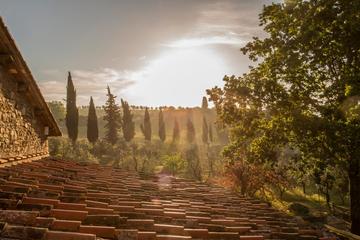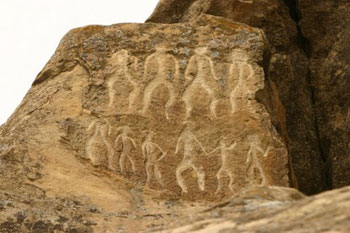
by Rusif Huseynov
Starting our trip from Baku, the capital of Azerbaijan with my brother I head south. The road along the beautiful shore of the Caspian Sea leads to Gobustan, one of the famous historical and mystic landmarks of the country. As children we were taken there once by our parents. But then a child’s outlook was not so capable to understand and estimate what we saw. Now it seems more exciting to go, walk around and explore.
Gobustan, which name in translation means “Ravine Land,” has a distinctive relief and full of muddy volcanoes. But that’s not the main thing that attracts thousands of tourists every year. That’s not what I and my brother want to see now.
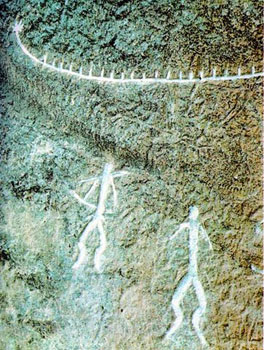 Declared a UNESCO World Heritage Site, Gobustan contains unique rock art engravings and images depicting the lifestyle, culture, economy, world outlook, magic and totemic conception, customs and traditions of the ancient inhabitants of the area. Long time ago the sea waves licked these mountains and then abandoned them leaving characteristic relief traces on the polished rocks.
Declared a UNESCO World Heritage Site, Gobustan contains unique rock art engravings and images depicting the lifestyle, culture, economy, world outlook, magic and totemic conception, customs and traditions of the ancient inhabitants of the area. Long time ago the sea waves licked these mountains and then abandoned them leaving characteristic relief traces on the polished rocks.
It takes us about an hour to reach the destination. A local guide offers her help, but we kindly reject. Sometimes it is much better to explore the area alone, trying to “read” what our forefathers have left for us, remembering the history of the discovery of Gobustan.
The petroglyphs of Gobustan were not discovered by an archeological expedition. In fact, their revelation came about quite by accident. In the 1930s, work was going on there in a stone quarry. The area is full of huge boulders and rock formations. One of the quarry workers noticed some unusual carvings on the rocks. The more the rocks were cut out, the more the paintings could be seen. (Before they had been hidden from view inside a huge pile of boulders.) Even more paintings were found inside what appeared to be man-made caves. Work at the quarry soon stopped so that the paintings could be examined more carefully. In the late 1930s the archeological investigations started. The scientists identified and documented approximately thousands of individual rock paintings during the next decades.
Gobustan has witnessed the life of area inhabitants from the prehistoric times through the Middle Ages till the modern era. Thousands of petroglyphs have been discovered in Gobustan. And that’s not all, the scientists think. Most of those rock engravings date back to the Stone Age. However, depicting petroglyphs continued till the Middle Ages.
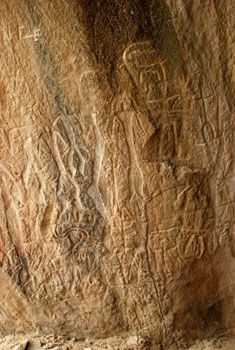 Gobustan rock carvings are marked with thematic diversity, plot originality, and certain artistic skill. Most of the petroglyphs depict people, domestic and wild animals, such as oxen, goats, gazelles, deer, horses, birds, fish, as well as battle scenes, ritual dances, bullfights, boats with men, hunting, fishing, solar symbols, etc.
Gobustan rock carvings are marked with thematic diversity, plot originality, and certain artistic skill. Most of the petroglyphs depict people, domestic and wild animals, such as oxen, goats, gazelles, deer, horses, birds, fish, as well as battle scenes, ritual dances, bullfights, boats with men, hunting, fishing, solar symbols, etc.
Whenever I come here, no matter it is my first or second or tenth visit, I feel that I am going to discover something new. Because this museum under open sky still hides a lot of secrets. It makes indescribable impressions to wander here in calm, to see all what the cold rocks have kept to themselves for millennia, to imagine all the scenes depicted by the pre-historic humans of this area.
Sometimes it feels and seems like the people and animals depicted on rocks are alive: the boatmen oar their boats, the hunters chase a wild gazelle, people perform a ritual dance, the bulls are ready to fight.
A lot of petroglyphs depict humans differently depending on the eras when they were made. Not skilled artists, however, the ancient drawers could distinguish men and women on their “masterpieces.” The women are naked, with big bosoms, narrow waists, wide hips, and thick legs. My brother sees and shows me some tattooed women. Probably those women had a higher status in the tribe. The men are presented as tall people with strong legs and muscular bodies. In many pictures they have weapons, such as bows and arrows in their hands.
Some rocks contain engravings depicting ritual dances. A similar row dance, known as “Yalli” in Azerbaijan, “Halay” in Turkey, is still performed here in Azerbaijan. I remind my brother how many times we have joined the people performing “Yalli”, which means unity and strength, at wedding parties. The petroglyphs show that it was a sacred ritual for our forefathers, who probably performed it around fire or before going to hunting.
The famous Norwegian traveler and explorer Thor Heyerdahl visited Gobustan several times throughout his life and emphasized the resemblance the Gobustan rock engravings with the petroglyphs discovered in Scandinavia. He tried to find the relations between the petroglyphs in two different parts of the world, and even proposed some hypotheses about the ties between the Vikings and Gobustan inhabitants.
 Personally, I am not sure about the presence of the Vikings in these areas. But the Romans were for sure. A rock found in Gobustan contains a Roman inscription which proves the presence of a centurion of the XII (12th) Roman legion, known as the Fulminat (Lightning) here on the shore of the Caspian Sea during the reign of Emperor Titus Flavius Domitianus in the second half the 1st century AD. Some assume, this may be the easternmost point any Roman patrol even ventured to. I can read the inscription though I am not good in Latin: “IMP DOMITIANO CAESARE AVG GERMANIC LIVIVS MAXIMVS LEG XII FVL” (“Emperor Domitian, the Blessed Caesar Germanicus. Livius Maximus, Legio XII Fulminata”).
Personally, I am not sure about the presence of the Vikings in these areas. But the Romans were for sure. A rock found in Gobustan contains a Roman inscription which proves the presence of a centurion of the XII (12th) Roman legion, known as the Fulminat (Lightning) here on the shore of the Caspian Sea during the reign of Emperor Titus Flavius Domitianus in the second half the 1st century AD. Some assume, this may be the easternmost point any Roman patrol even ventured to. I can read the inscription though I am not good in Latin: “IMP DOMITIANO CAESARE AVG GERMANIC LIVIVS MAXIMVS LEG XII FVL” (“Emperor Domitian, the Blessed Caesar Germanicus. Livius Maximus, Legio XII Fulminata”).
Apart from petroglyphs, there is also a musical gemstone known as the Gaval Dash or Tambourine stone as they call it in English. It makes a tambourine-like sound when it is hit in different points. Visitors attending this site never leave without playing on it. Musical sounds come from the Gaval Dash when touching it with a small stone. The Gaval Dash has been formed due the combination of unique climate, oil and gas which can be found in the region of Azerbaijan. Of course, I played on this witness of millennia too, wishing the air of Gobustan to keep my melodies for many years from now.
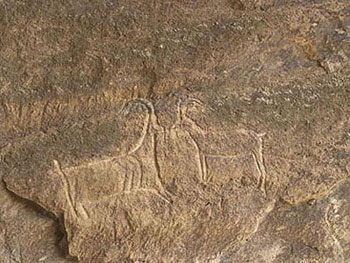 Near the end of our trip I ask my brother whether he would like to see the “Gobustan kitchen”. He first think I am joking. But I am not. I take him to the place I have read about many times and show him the bowl-shaped depressions carved out in the rock. They were probably used for collecting rainwater, the blood of sacrificed animals or for cooking. I remember from the old people that until quite recently mountain shepherds used these “bowls” for boiling milk by dropping heated stones into them. It may be an explanation about the usage of similar “bowls” by the prehistoric people.
Near the end of our trip I ask my brother whether he would like to see the “Gobustan kitchen”. He first think I am joking. But I am not. I take him to the place I have read about many times and show him the bowl-shaped depressions carved out in the rock. They were probably used for collecting rainwater, the blood of sacrificed animals or for cooking. I remember from the old people that until quite recently mountain shepherds used these “bowls” for boiling milk by dropping heated stones into them. It may be an explanation about the usage of similar “bowls” by the prehistoric people.
Gobustan is considered one of the symbols of Azerbaijan. It is more than just a museum or a landmark. I dare to call the place an honor for the nation. The Gobustan rocks are depicted on national postcards, stamps and even on the reverse of the 2006 series of the national currency banknotes, manat. Whenever you visit Azerbaijan, don’t forget to attend Gobustan. Or don’t worry about forgetting, because you will be reminded, even taken there by hospitable local people.
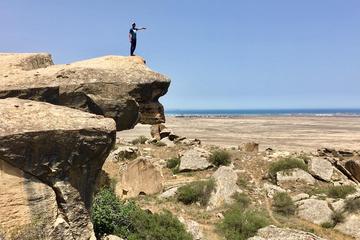
Gobustan Rock Art Museum and Mud Volcano
If You Go:
If you are traveling from Baku you can reach Gobustan on the bus to Alat. It is easy to take a taxi or rent a car. It will take you 40-60 minutes to reach the destination. The main petroglyphs site is about five kilometers west of the settlement of Gobustan itself. Plan your journey carefully as currently there is no hotel in Gobustan.
Gobustan National Historical Preserve
3 Lermontov Str.
Baku, AZ 1006, Azerbaijan
Tel: +994 12 492 61 45
Fax: +994 12) 492 02 54
General Office:
office@gobustan-rockart.az
Work time: 10.30 am – 4.30 pm (daily)
About the author:
Rusif Huseynov was in Baku, Azerbaijan. He is interested in world history and geography. He speaks Azerbaijani (mother tongue), Russian, English, Turkish and some German. Among his hobbies are collecting postcards and key chains from different countries. One of his dreams is to travel all over the world.
All photos are by Rusif Huseynov.


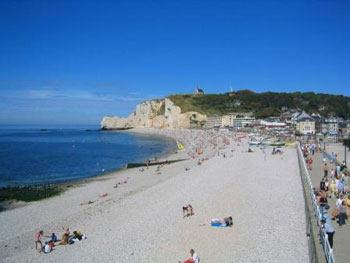
 The chalky north coast of Normandy captures the heart of every visitor at first sight. Years of seawater erosion and weathering have sculpted the coastline on both the west and east sides of the beach, leaving behind towering white cliffs and protruding headlands pierced by arches of various sizes. No wonder Monet visited Étretat every year between 1883 and 1886 and produced more than 60 paintings.
The chalky north coast of Normandy captures the heart of every visitor at first sight. Years of seawater erosion and weathering have sculpted the coastline on both the west and east sides of the beach, leaving behind towering white cliffs and protruding headlands pierced by arches of various sizes. No wonder Monet visited Étretat every year between 1883 and 1886 and produced more than 60 paintings.
 “You are right to envy me. You cannot have any idea how beautiful the sea has been for two days, but what talent it will take to render it, it’s crazy. As for the cliffs, they are like nowhere else. Yesterday, I climbed down to a spot where I had never ventured to go before and saw wonderful things there so I very quickly went back to get my canvases. In the end, I am very happy.”
“You are right to envy me. You cannot have any idea how beautiful the sea has been for two days, but what talent it will take to render it, it’s crazy. As for the cliffs, they are like nowhere else. Yesterday, I climbed down to a spot where I had never ventured to go before and saw wonderful things there so I very quickly went back to get my canvases. In the end, I am very happy.” Following the trail all the way to the top of Manneporte, I could see, on the east side, Porte d’Aval and Pointe d’Aiguille again next to each other as in L’Aiguille et la Porte d’Aval, Étretat. Monet painted the same motif from the beach below us as well. Bathed in the mellow evening light during low tide, the pillar and the arch in the painting hardly appear overwhelming although they still look gigantic compared with the tiny boats between them. While the view before me was imposing, the painting impressed me with its serenity.
Following the trail all the way to the top of Manneporte, I could see, on the east side, Porte d’Aval and Pointe d’Aiguille again next to each other as in L’Aiguille et la Porte d’Aval, Étretat. Monet painted the same motif from the beach below us as well. Bathed in the mellow evening light during low tide, the pillar and the arch in the painting hardly appear overwhelming although they still look gigantic compared with the tiny boats between them. While the view before me was imposing, the painting impressed me with its serenity.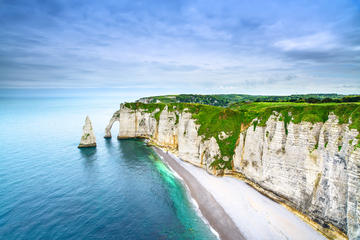
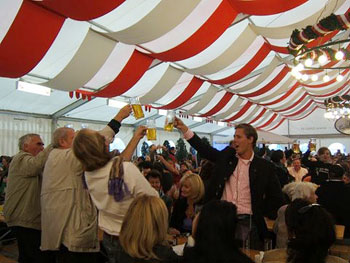
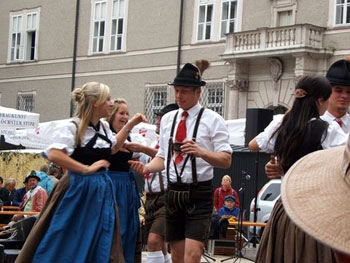 Spinning rides and vendor booths pack the central square. They are selling wooden toys and traditional crafts and that curious gingerbread that seems to be a fixture of the German-speaking festival: heart-shaped with endearments printed in icing, meant to be worn around the neck. There’s music in the streets, and a group has gathered around to watch an old couple who is dancing a slow waltz. I’m surprised to see how many people have arrived wearing the traditional lederhosen and dirndls. As I squeeze my way between hordes of carousing Austrians, I feel as if I have arrived in the wrong city. I hadn’t pictured the town of Mozart’s birth to have such activity.
Spinning rides and vendor booths pack the central square. They are selling wooden toys and traditional crafts and that curious gingerbread that seems to be a fixture of the German-speaking festival: heart-shaped with endearments printed in icing, meant to be worn around the neck. There’s music in the streets, and a group has gathered around to watch an old couple who is dancing a slow waltz. I’m surprised to see how many people have arrived wearing the traditional lederhosen and dirndls. As I squeeze my way between hordes of carousing Austrians, I feel as if I have arrived in the wrong city. I hadn’t pictured the town of Mozart’s birth to have such activity.
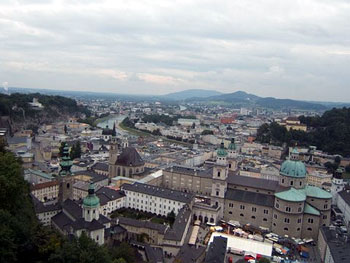 The older gentleman sitting across from me tries to engage me in conversation, so I bust out my best German – in my poor imitation of the Northern German accent I had learned in school. I might as well have been speaking gibberish to the Austrian, so we settle on my native tongue. A pair of women join the stilted English conversation, and I finally learn that September 24th is the Feast of St. Rupert, the patron saint of Salzburg. The festival in town occurs on the weekend each year closest to that date.
The older gentleman sitting across from me tries to engage me in conversation, so I bust out my best German – in my poor imitation of the Northern German accent I had learned in school. I might as well have been speaking gibberish to the Austrian, so we settle on my native tongue. A pair of women join the stilted English conversation, and I finally learn that September 24th is the Feast of St. Rupert, the patron saint of Salzburg. The festival in town occurs on the weekend each year closest to that date. But then the three Austrians start a new game that I can only describe as ‘inebriate the foreigner’. A second beer from my new friends is in order, but that isn’t all. I’m obliged to accept a glass of Sturm, a young red wine that tastes amazingly like grape juice. Dangerous for a heavy drinker, but very tasty. A wink from the man and scrunched noses from the women tell me I’m in trouble at their next plot. A girl wearing both a long dirndl dress and a barrel comes by our table. The Austrians hand the girl money, and a single shotglass of clear liquid is placed in front of me. All eyes turn my way and I feel a twinge of foreboding.
But then the three Austrians start a new game that I can only describe as ‘inebriate the foreigner’. A second beer from my new friends is in order, but that isn’t all. I’m obliged to accept a glass of Sturm, a young red wine that tastes amazingly like grape juice. Dangerous for a heavy drinker, but very tasty. A wink from the man and scrunched noses from the women tell me I’m in trouble at their next plot. A girl wearing both a long dirndl dress and a barrel comes by our table. The Austrians hand the girl money, and a single shotglass of clear liquid is placed in front of me. All eyes turn my way and I feel a twinge of foreboding.
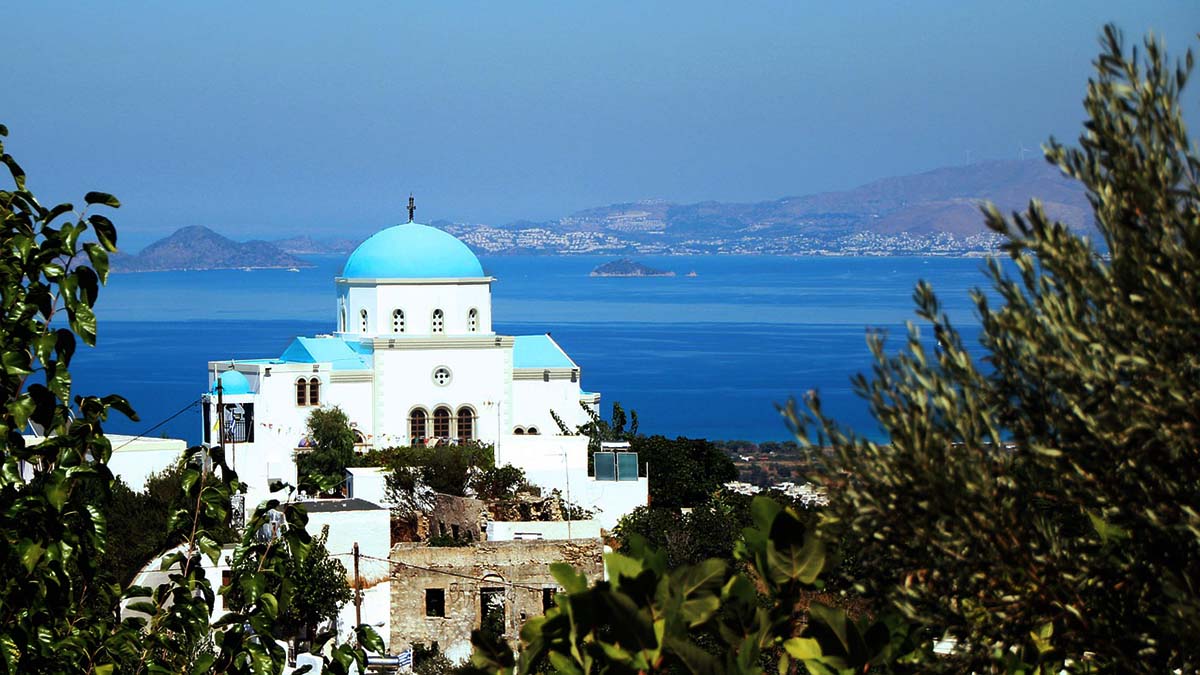
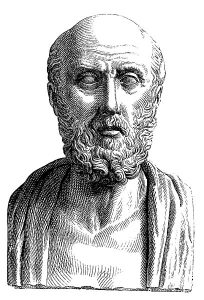
 Hippocrates Tree is located in Kos Town. It is said Hippocrates stood under this plane-tree and lectured his medical students. Although it is unlikely that it is the actual tree under which Hippocrates stood, a far more plausible explanation is that the current tree is a descendant of the one under which Hippocrates lectured. Many health establishments around the world have taken cuttings from this tree and planted them in their own grounds. Hippocrates tree is easy to distinguish as it is supported by a large metal framework. I could not help but feel impressed that a man to whom medicine owes so much might have once stood in this same spot.
Hippocrates Tree is located in Kos Town. It is said Hippocrates stood under this plane-tree and lectured his medical students. Although it is unlikely that it is the actual tree under which Hippocrates stood, a far more plausible explanation is that the current tree is a descendant of the one under which Hippocrates lectured. Many health establishments around the world have taken cuttings from this tree and planted them in their own grounds. Hippocrates tree is easy to distinguish as it is supported by a large metal framework. I could not help but feel impressed that a man to whom medicine owes so much might have once stood in this same spot.
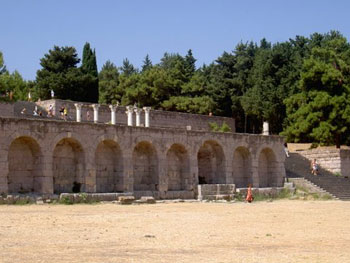 The sick would visit the Asklepion which was staffed by several therapists, priests and later doctors. The patient stayed for a few days and might take part in massage, gymnastics, bathing and follow a special diet.
The sick would visit the Asklepion which was staffed by several therapists, priests and later doctors. The patient stayed for a few days and might take part in massage, gymnastics, bathing and follow a special diet.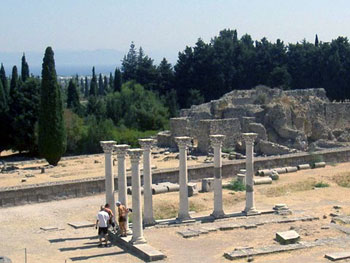 As you approach the Asklepion it opens out in front of you and you can clearly see the three levels that make it up. Naturally, the main temple to Asklepios is at the top. I made my way slowly to the top, partly due to the heat but also so as not to miss anything on the way. My guidebook informed me that the lower levels were once accommodation and that the second terrace contained smaller temples, including one to Apollo. The authentic columns, arches and stone steps still look impressive and make you wonder about the people who used the Asklepios as a centre of healing all those years ago.
As you approach the Asklepion it opens out in front of you and you can clearly see the three levels that make it up. Naturally, the main temple to Asklepios is at the top. I made my way slowly to the top, partly due to the heat but also so as not to miss anything on the way. My guidebook informed me that the lower levels were once accommodation and that the second terrace contained smaller temples, including one to Apollo. The authentic columns, arches and stone steps still look impressive and make you wonder about the people who used the Asklepios as a centre of healing all those years ago.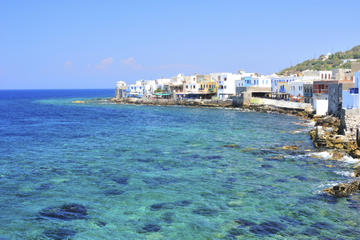
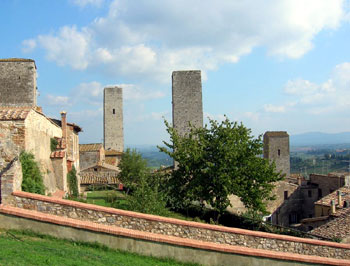
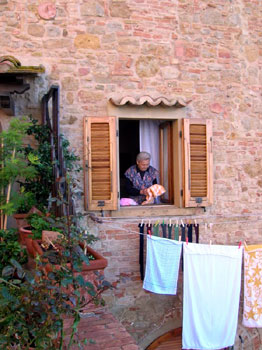 The first written records of this Estrucan village are from 929 AD. Named for the former Bishop of Modena in the 10th century San Gimignano is a Unesco World Heritage site and is also known as the city of beautiful towers. During The Middle Ages while at the peak of it’s influence this town boasted fifty-six towers, some standing more then fifty meters tall and visible from anywhere in the Elsa Valley. These towers were not only status symbols to local families as well they served as a medieval early warning system should would be invaders approach. Because of war, the Black Plague in the 14th century, urban renewal and other catastrophes only fourteen of the towers remain and only one, The Grossa tower was open for our viewing.
The first written records of this Estrucan village are from 929 AD. Named for the former Bishop of Modena in the 10th century San Gimignano is a Unesco World Heritage site and is also known as the city of beautiful towers. During The Middle Ages while at the peak of it’s influence this town boasted fifty-six towers, some standing more then fifty meters tall and visible from anywhere in the Elsa Valley. These towers were not only status symbols to local families as well they served as a medieval early warning system should would be invaders approach. Because of war, the Black Plague in the 14th century, urban renewal and other catastrophes only fourteen of the towers remain and only one, The Grossa tower was open for our viewing.
 Being surrounded by so much history can be a little over whelming so we took a time out to clear our heads and check out the terra cotta and glazed pottery. Crafts and pottery that have been produced by local artisans are abundant in the open-air market and shops along Via Giovanni. I couldn’t resist bringing a handcrafted ornament home for my grand daughter.
Being surrounded by so much history can be a little over whelming so we took a time out to clear our heads and check out the terra cotta and glazed pottery. Crafts and pottery that have been produced by local artisans are abundant in the open-air market and shops along Via Giovanni. I couldn’t resist bringing a handcrafted ornament home for my grand daughter. Fattorio Lischeto boasts a restored rustic farmhouse where we enjoyed the best of Tuscan cuisine and the company of fellow travelers from around the globe. The panoramic views of the surrounding farmland, Cypress groves, rolling hills and valleys could only surpassed the crispy crostini and pancheta, organic pecorino cheese, panchino tomatoes freshly picked from the garden and a drizzle of virgin olive oil. I still smile when I think of the organic Chianti.
Fattorio Lischeto boasts a restored rustic farmhouse where we enjoyed the best of Tuscan cuisine and the company of fellow travelers from around the globe. The panoramic views of the surrounding farmland, Cypress groves, rolling hills and valleys could only surpassed the crispy crostini and pancheta, organic pecorino cheese, panchino tomatoes freshly picked from the garden and a drizzle of virgin olive oil. I still smile when I think of the organic Chianti.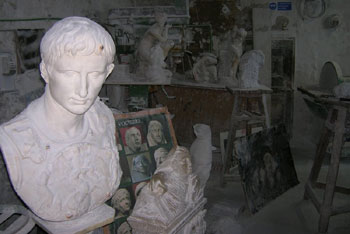 While San Gimignano is a busy tourist destination Volterra is what I had envisioned when I thought about an ancient Estrucan town. The City of Alabaster as it is known became important in the 18th century in part because of the quality and transparency of the alabaster in the region. To this day craftsman work in the dust filled workshops where you can watch them work and spend whatever amount you desire large or small for your memories. In celebration of their history of carving Volterra’s Museum of Alabaster boasts over three hundred original pieces, displayed in a 17th century convent.
While San Gimignano is a busy tourist destination Volterra is what I had envisioned when I thought about an ancient Estrucan town. The City of Alabaster as it is known became important in the 18th century in part because of the quality and transparency of the alabaster in the region. To this day craftsman work in the dust filled workshops where you can watch them work and spend whatever amount you desire large or small for your memories. In celebration of their history of carving Volterra’s Museum of Alabaster boasts over three hundred original pieces, displayed in a 17th century convent.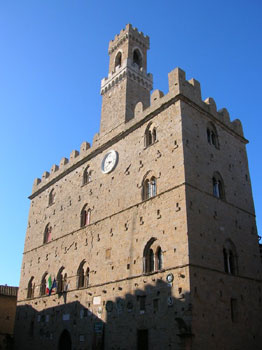 Early Roman influence is apparent in Volterra with the recent (in Tuscan time) discovery of the ruins of the Theatre of Vallebona from the 1st century and spa buildings from the Augustun age (5th century). Many of the archaeological finds from digs in and around Volterra and the Elsa Valley are displayed in the Guarnacci Museum, one of the first public museums in Europe that was founded in 1761 while the Romanesque style church of St. Agostino is the home to remnants of famous frescoes.
Early Roman influence is apparent in Volterra with the recent (in Tuscan time) discovery of the ruins of the Theatre of Vallebona from the 1st century and spa buildings from the Augustun age (5th century). Many of the archaeological finds from digs in and around Volterra and the Elsa Valley are displayed in the Guarnacci Museum, one of the first public museums in Europe that was founded in 1761 while the Romanesque style church of St. Agostino is the home to remnants of famous frescoes.